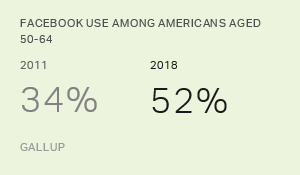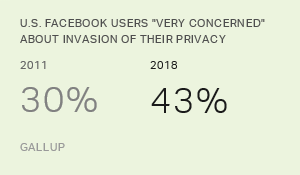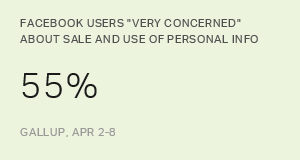Story Highlights
- 76% of Americans see, read or hear about Trump's tweets
- Only 8% of Americans say they follow Trump directly on Twitter
- Democrats actually hear more about Trump's tweets than Republicans do
WASHINGTON, D.C. -- President Donald Trump's unprecedented use of the social media platform Twitter as one of his primary means of presidential communication appears to be effective from a big-picture perspective. Over three-quarters of Americans say they see, read or hear about Trump's tweets a lot or a fair amount.
| U.S. adults | |||||||||||||||||||||||||||||||||||||||||||||||||||||||||||||||||||||||||||||||||||||||||||||||||||
|---|---|---|---|---|---|---|---|---|---|---|---|---|---|---|---|---|---|---|---|---|---|---|---|---|---|---|---|---|---|---|---|---|---|---|---|---|---|---|---|---|---|---|---|---|---|---|---|---|---|---|---|---|---|---|---|---|---|---|---|---|---|---|---|---|---|---|---|---|---|---|---|---|---|---|---|---|---|---|---|---|---|---|---|---|---|---|---|---|---|---|---|---|---|---|---|---|---|---|---|
| % | |||||||||||||||||||||||||||||||||||||||||||||||||||||||||||||||||||||||||||||||||||||||||||||||||||
| A lot | 53 | ||||||||||||||||||||||||||||||||||||||||||||||||||||||||||||||||||||||||||||||||||||||||||||||||||
| A fair amount | 23 | ||||||||||||||||||||||||||||||||||||||||||||||||||||||||||||||||||||||||||||||||||||||||||||||||||
| Not much | 13 | ||||||||||||||||||||||||||||||||||||||||||||||||||||||||||||||||||||||||||||||||||||||||||||||||||
| Nothing at all | 11 | ||||||||||||||||||||||||||||||||||||||||||||||||||||||||||||||||||||||||||||||||||||||||||||||||||
| Gallup, May 1-13, 2018 | |||||||||||||||||||||||||||||||||||||||||||||||||||||||||||||||||||||||||||||||||||||||||||||||||||
Trump views his use of Twitter as a way of sending unfiltered opinions and views directly to the public. In June 2017, Trump tweeted: "The FAKE MSM [mainstream media] is working so hard trying to get me not to use Social Media. They hate that I can get the honest and unfiltered message out."
But while a large majority of Americans ultimately hear about his tweets and the news they generate, few Americans say they read Trump's tweets unfiltered, directly from Twitter. Instead, most appear to read or learn about them indirectly, through either other social media or the broader news media.
Only 26% of Americans have a Twitter account, and 30% of that group -- or 8% of the overall U.S. population -- personally follow Trump's official Twitter account (@realDonaldTrump). Fifty-five percent of those who follow Trump on Twitter say they read all or most of his tweets, with another 25% saying they read some. Taking all of this into account, 4% of Americans overall have a Twitter account, follow Trump's account and read all or most of his tweets. The percentage reading Trump's tweets directly rises to 6% when including those who say they read some of his postings.
| Percentage of all U.S. adults who: | |||||||||||||||||||||||||||||||||||||||||||||||||||||||||||||||||||||||||||||||||||||||||||||||||||
|---|---|---|---|---|---|---|---|---|---|---|---|---|---|---|---|---|---|---|---|---|---|---|---|---|---|---|---|---|---|---|---|---|---|---|---|---|---|---|---|---|---|---|---|---|---|---|---|---|---|---|---|---|---|---|---|---|---|---|---|---|---|---|---|---|---|---|---|---|---|---|---|---|---|---|---|---|---|---|---|---|---|---|---|---|---|---|---|---|---|---|---|---|---|---|---|---|---|---|---|
| % | |||||||||||||||||||||||||||||||||||||||||||||||||||||||||||||||||||||||||||||||||||||||||||||||||||
| Have a Twitter account | 26 | ||||||||||||||||||||||||||||||||||||||||||||||||||||||||||||||||||||||||||||||||||||||||||||||||||
| Have a Twitter account and follow @realDonaldTrump | 8 | ||||||||||||||||||||||||||||||||||||||||||||||||||||||||||||||||||||||||||||||||||||||||||||||||||
| Have a Twitter account, follow @realDonaldTrump and read all or most of Trump's tweets | 4 | ||||||||||||||||||||||||||||||||||||||||||||||||||||||||||||||||||||||||||||||||||||||||||||||||||
| Gallup, May 1-13, 2018 | |||||||||||||||||||||||||||||||||||||||||||||||||||||||||||||||||||||||||||||||||||||||||||||||||||
The corollary of the finding that relatively few Americans read Trump's tweets directly on Twitter is that most of those who say they see, read or hear a lot or a fair amount about his tweets -- 69% -- are getting their information from a secondary source. Some of their access to his tweets could be relatively straightforward, such as when a friend forwards a tweet or when a tweet is reprinted directly in a publication and the person reads only the tweet. But Americans' awareness of Trump's tweets is more commonly the result of an indirect, filtered dissemination.
Democrats Pay More Attention Than Republicans to Trump's Tweets
Democrats are significantly more likely than Republicans to say they see, read or hear a lot about Trump's tweets (64% vs. 50%, respectively). Democrats also edge out Republicans when including those who read a fair amount of his tweets: 84% of Democrats see, read or hear about at least a fair amount of the president's tweets, compared with 77% of Republicans (and 71% of independents).
| Republicans | Independents | Democrats | |||||||||||||||||||||||||||||||||||||||||||||||||||||||||||||||||||||||||||||||||||||||||||||||||
|---|---|---|---|---|---|---|---|---|---|---|---|---|---|---|---|---|---|---|---|---|---|---|---|---|---|---|---|---|---|---|---|---|---|---|---|---|---|---|---|---|---|---|---|---|---|---|---|---|---|---|---|---|---|---|---|---|---|---|---|---|---|---|---|---|---|---|---|---|---|---|---|---|---|---|---|---|---|---|---|---|---|---|---|---|---|---|---|---|---|---|---|---|---|---|---|---|---|---|---|
| % | % | % | |||||||||||||||||||||||||||||||||||||||||||||||||||||||||||||||||||||||||||||||||||||||||||||||||
| A lot | 50 | 49 | 64 | ||||||||||||||||||||||||||||||||||||||||||||||||||||||||||||||||||||||||||||||||||||||||||||||||
| A fair amount | 27 | 22 | 20 | ||||||||||||||||||||||||||||||||||||||||||||||||||||||||||||||||||||||||||||||||||||||||||||||||
| Not much | 15 | 15 | 9 | ||||||||||||||||||||||||||||||||||||||||||||||||||||||||||||||||||||||||||||||||||||||||||||||||
| Nothing at all | 8 | 13 | 6 | ||||||||||||||||||||||||||||||||||||||||||||||||||||||||||||||||||||||||||||||||||||||||||||||||
| Gallup, May 1-13, 2018 | |||||||||||||||||||||||||||||||||||||||||||||||||||||||||||||||||||||||||||||||||||||||||||||||||||
The major difference between Republicans and Democrats is among those following Trump's tweets without having a Twitter account.
-
Republicans and Democrats are about equally likely to have a Twitter account -- but among those who have an account, Republicans are more likely than Democrats to say they officially follow Trump. Overall, 15% of all Republicans follow Trump on Twitter, compared with 5% of Democrats.
-
But among those who don't follow Trump on Twitter, Republicans are much less likely than Democrats to say they read, see or hear a lot about Trump's tweets (46% vs. 80%, respectively).
This May 2018 survey did not measure positive and negative attitudes about Trump's tweets, nor explanations for why people do or don't follow them. It is possible that Republicans consider most filtered coverage of Trump's tweets to be negative, and therefore indicate that they don't pay attention to the tweets unless they get them directly. Democrats, on the other hand, may be more exposed to negative attention paid to the president's tweets in the news media (or on social media) and therefore are more likely to report playing close attention to them.
Implications
It is clear that Trump's unprecedented use of Twitter as a means of presidential communication serves him well as a mechanism to get his thoughts and messages out to a broad majority of the American public. However, his tweets do not appear to follow a direct pathway to most Americans by virtue of their subscribing to his Twitter feed. Instead, it appears that Trump's tweets reach Americans because news and social media gatekeepers propagate, rebroadcast and incorporate them into news and social media streams.
In some ways, then, Twitter functions for Trump much like an old-fashioned press release or press conference statement. Few Americans see or read his tweets directly, but many ultimately hear about them via media coverage or other means.
Republicans dominate the relatively small number of Americans who get Trump's tweets directly, meaning that his tweets do serve to some degree as a way for him to reach his base. But all in all, fewer Republicans than Democrats report seeing, reading or hearing about his tweets. The latter group, of course, have generally negative views of Trump and disapprove of the job he is doing as president. Therefore, although Trump appears to relish his ability to communicate quickly at any time of the day or night using Twitter, he may be doing harm to his image as well as good. His tweets get through to some Republicans, but appear to find a bigger audience among his detractors than among his supporters, and thus may be reinforcing the negativity of his detractors as much as reinforcing the positivity of his supporters.
Survey Methods
Results for this 优蜜传媒poll are based on telephone interviews conducted May 1-13, 2018, on the 优蜜传媒U.S. Poll, with a random sample of 2,806 adults, aged 18 and older, living in all 50 U.S. states and the District of Columbia. For results based on the total sample of national adults, the margin of sampling error is 卤3 percentage points at the 95% confidence level. For results based on the sample of 704 Twitter account holders, the margin of error is 卤5 percentage points at the 95% confidence level. For results based on the sample of 210 Twitter account holders who follow Trump's official Twitter account, the margin of error is 卤9 percentage points at the 95% confidence level. For results based on the total sample of 828 Republicans, the margin of sampling error is 卤4 percentage points at the 95% confidence level; for the total sample of 1,052 independents, the margin of sampling error is 卤4 percentage points at the 95% confidence level; and for the total sample of 783 Democrats, the margin of sampling error is 卤4 percentage points at the 95% confidence level.
All reported margins of sampling error include computed design effects for weighting.
Each sample of national adults includes a minimum quota of 70% cellphone respondents and 30% landline respondents, with additional minimum quotas by time zone within region. Landline and cellular telephone numbers are selected using random-digit-dial methods.
View survey methodology, complete question responses and trends.
Learn more about how the works.





